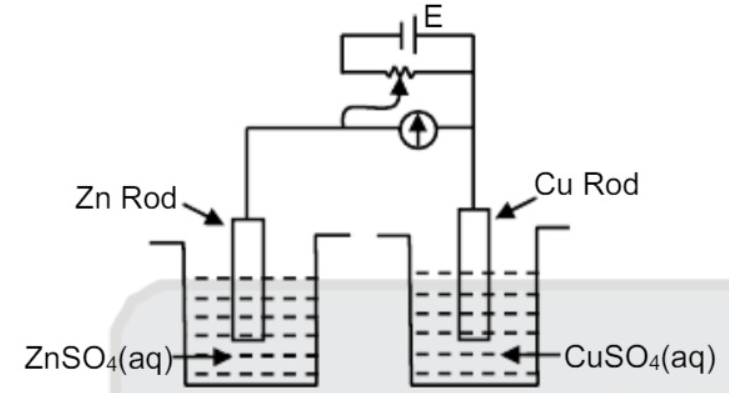Calculate the number of coulombs delivered by a Daniel cell, initially containing 1 litre each of 1M Cu2+and1MZn2+ ion which is operated until its potential drops to 1V.
E∘Cu2+,Cu=0.34V,E∘Zn2+,Zn=−0.76V
To solve the problem of calculating the number of coulombs delivered by a Daniel cell, we will follow these steps:
Step 1: Identify the half-reactions and the overall cell reaction
In a Daniel cell, the oxidation and reduction half-reactions are as follows:
- Oxidation (Anode): Zinc is oxidized to zinc ions.
Zn (s)→Zn2+(aq)+2e−
- Reduction (Cathode): Copper ions are reduced to copper metal.
Cu2+(aq)+2e−→Cu (s)
The overall cell reaction can be written as:
Zn (s)+Cu2+(aq)→Zn2+(aq)+Cu (s)
Step 2: Determine the number of electrons transferred
From the balanced equation, we can see that 2 moles of electrons are transferred per mole of zinc consumed and copper deposited.
Step 3: Calculate the total charge transferred
The total charge (Q) transferred can be calculated using the formula:
Q=n×F
where:
- n = number of moles of electrons transferred
- F = Faraday's constant (96500C/mol)
Since we have 1 mole of zinc reacting, the number of moles of electrons transferred is:
n=2moles of electrons
Now substituting the values:
Q=2moles×96500C/mol=193000C
Step 4: Consider the potential drop
The problem states that the cell operates until its potential drops to 1V. However, since we are calculating the total charge delivered based on the complete reaction, the potential drop does not affect the total charge calculated from the stoichiometry of the reaction.
Final Answer
The total charge delivered by the Daniel cell until its potential drops to 1V is:
Q=193000C
---
In a Daniel cell, the oxidation and reduction half-reactions are as follows:
- Oxidation (Anode): Zinc is oxidized to zinc ions.
Zn (s)→Zn2+(aq)+2e−
- Reduction (Cathode): Copper ions are reduced to copper metal.
Cu2+(aq)+2e−→Cu (s)
Zn (s)+Cu2+(aq)→Zn2+(aq)+Cu (s)
From the balanced equation, we can see that 2 moles of electrons are transferred per mole of zinc consumed and copper deposited.
The total charge (Q) transferred can be calculated using the formula:
Q=n×F
where:
- n = number of moles of electrons transferred
- F = Faraday's constant (96500C/mol)
n=2moles of electrons
Q=2moles×96500C/mol=193000C
The problem states that the cell operates until its potential drops to 1V. However, since we are calculating the total charge delivered based on the complete reaction, the potential drop does not affect the total charge calculated from the stoichiometry of the reaction.
The total charge delivered by the Daniel cell until its potential drops to 1V is:
Q=193000C
Topper's Solved these Questions
- ELECTROMOTIVE FORCE BOOK - RC MUKHERJEECHAPTER - ELECTROMOTIVE FORCE EXERCISE - PROBLEMS
26 Videos
- ELECTROMOTIVE FORCE BOOK - RC MUKHERJEECHAPTER - ELECTROMOTIVE FORCE EXERCISE - EXERCISE
1 Videos
- ELECTROLYSIS AND ELECTROLYTIC CONDUCTANCEBOOK - RC MUKHERJEECHAPTER - ELECTROLYSIS AND ELECTROLYTIC CONDUCTANCEEXERCISE - Objective Problems
39 Videos
- ELEMENTARY PROBLEMS BASED ON DEFINITION OF MOLE: THE MOLE CONCEPT BOOK - RC MUKHERJEECHAPTER - ELEMENTARY PROBLEMS BASED ON DEFINITION OF MOLE: THE MOLE CONCEPT EXERCISE - OBJECTIVE PROBLEMS
29 Videos
Similar Questions
Calculate the quantity of electricity dellvered by a Daniel celi initially containing 1 L each of 1M Cu2+ ion and 1M Zn2+ C which is operated until potential drops to 1V. Given E∘Zn2+/Zn=−0.76V,E∘Cu2+/Cu=+0.34V
View SolutionCalculate the potential of a Daniel cell, initially containing 1 litre each of 1M Cu2+and1MZn2+ after a passage of 1×105 coulombs of charge . E∘Cu2+,Cu=+0.34V,E∘Zn2+,Zn=−0.76V
View Solution
Knowledge Check
The emf in V of Danneil cell containing 0.1 M ZnSO4 and 0.01 M CuSO4 solutions their respective electrodes is E∘Cu2+∣Cu=0.34V and E∘Zn2+∣Zn=−0.76 V
A1.10 VB1.16 VC1.13 VD1.07 VFor the given cell arrangement identify incorrect statement
given E∘_(Cu2+/Cu) = 0.34V &E∘_(Zn2+/Zn)=−0.76V AIf Eext>1.1V,Zn dissolves at Zn electrode and Cu deposits at Cu electrodeBIf Eext>1.1V,e− flows from Cu to ZnCIf Eext<1.1V,Zn dissolves at anode and Cu deposits at cathodeDIf Eext=1.1V, no flow of e− or current occurs
AIf Eext>1.1V,Zn dissolves at Zn electrode and Cu deposits at Cu electrodeBIf Eext>1.1V,e− flows from Cu to ZnCIf Eext<1.1V,Zn dissolves at anode and Cu deposits at cathodeDIf Eext=1.1V, no flow of e− or current occursFor the given cell arrangement identify incorrect statement
given E∘_(Cu2+/Cu) = 0.34V &E∘_(Zn2+/Zn)=−0.76V AAt E=1.1V no electron will flowBAt E>1.1V electron will flow from Cu to ZnCAt E<1.1V Zn will dissolve and Cu will depositDAt E<1.1V Zn will diposit and Cu will dissolve
AAt E=1.1V no electron will flowBAt E>1.1V electron will flow from Cu to ZnCAt E<1.1V Zn will dissolve and Cu will depositDAt E<1.1V Zn will diposit and Cu will dissolve
Why blue colour of CuSO4 solution gets discharged when zinc rod is dipped in it ? Given, E∘Cu+2/Cu=0.34VandE∘Zn+2/Zn=−0.76V
View SolutionFor the cell : Zn∣∣∣Zn2+aq.1M∣∣∣∣∣∣Cu2+aq.2M∣∣∣Cu
Calculate the values for ,
(a) cell reaction,
(b) E∘cell
(c) Ecell
(d) the minimum concentration of Cu2+ at which cell reaction is spontaneous if Zn2+ is 1M,
(e) does the displacement of Cu2+ goes almost to completion.
Given : E∘RPCu2/Cu=+0.35V
E∘RPZn2/Zn=−0.76V
View SolutionWhy blue colour of CuSO4 solution gets discharged when zinc rod is dipped in it ? Given, E∘Cu+2/Cu=0.34VandE∘Zn+2/Zn=−0.76V
View SolutionWhy blue colour of CuSO4 solution gets discharged when zinc rod is dipped in it ? Given, E∘Cu+2/Cu=0.34VandE∘Zn+2/Zn=−0.76V
View SolutionThe standard cell potential for the cell Zn∣∣Zn2+(1M)∣∣∣∣Cu2+(1M)∣∣Cu
Given E∘Cu2+/Cu=0.34V and E∘Zn2+/Zn=−0.76V is
View Solution
